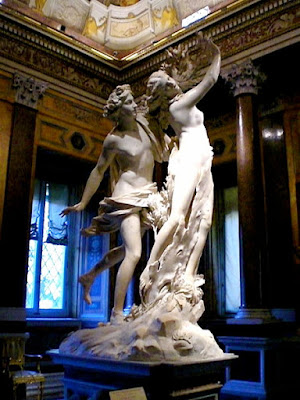I guess the title makes my subject pretty obvious. And I have to tell you, there are about a million statues (sounds like an exaggeration, but doesn't feel like one) that depict both Roman and Greek mythology. They are my favorite kind because they tell a story. There is so much emotion and feeling involved, not to mention the constant themes of falling in love and resisting brute lust. We have always liked our dramas - even hundreds of years ago.
 |
| Perseus and Medusa, by Antonio Canova, from study.com |
Antonio Canova is one of my favorites. Above is Perseus and Medusa, currently on display at The Met in New York. When I see this I think of the more modern telling involving Percy Jackson. My absolute favorite Canova is this:
 |
| Cupid and Psyche, by Antonio Canova, from The Louvre |
In this interpretation of Cupid and Psyche I see the most caring and intense love. It's difficult not to like this statue. When Mike and I went to the Hermitage we had to wait a while to get a close-up view. Their is also a copy in the Louvre and in The Met. Cupid was so forgiving of Psyche's human nature; it is a beautiful story and a gorgeous statue to go with it.
The story of Apollo and Daphne is another one of my favorites, probably because I have a sister named Daphne. When she first discovered that her name meant "Laurel Tree," she was a little disappointed. But during our teen years when she learned the story behind the Laurel tree, she came to love the meaning of her name and the story behind it.
When I think of this story I don't think of a girl who is constantly avoiding a nuisance and turns into a tree just to get rid of him. I think of a man so persistent in his desires, much like Gaston of Beauty and the Beast, that he will do anything to get what he wants. In order to save herself - possibly from rape - Daphne turns into a Laurel tree.
The tragedy of Laocoon and His Sons, spoken of in the Greek Epic Cycle, is about a Trojan priest who was going to leak information about the Trojan Horse, so his two sons killed him. Here he is portrayed with sea serpents. The story varies in its different versions (and what Greek story doesn't have a hundred different versions?).
Okay, there's not necessarily a story to go with this one, but it is a Greco-Roman piece of an athlete about to release the discus "by sheer intelligence." It's a really cool statue. Look at all the details on that guy.
Perhaps one of the more tragic stories is that of Persephone, who was kidnapped by Hades (with the help of Zeus of all people) and taken as his wife. I love this sculpture because of the intense emotions I get from it; panic, immediacy, and fear. I know that sounds warped, but I don't love it because of the fear you can feel, but because Bernini has the ability to make us feel those emotions. This story can be real life, and it's scary, and hopefully makes us aware and more sympathetic human beings.
Another one of my favorites, a good one to end on, is the Venus de Milo. This is a simple portrait of Venus (or Aphrodite), the goddess of love. I remember this from the movie about that surfer who lost her arm to a shark (I can't remember the name of it) and how her mother showed her this statue and talked about how millions of people have flocked to Paris to see it and how beautiful it was. Even though the arms were lost long ago. Profound, right?
Until next time, enjoy. Look up some more statues with these themes, they're all so amazing!








Comments
Post a Comment